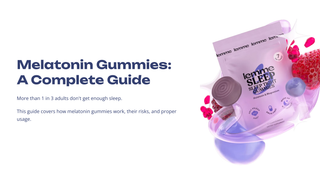Struggling to fall asleep and wondering if melatonin gummies are the answer?
More than one in three adults say they don’t get enough sleep. If you’ve ever found yourself lying in bed, wide-eyed at 2am, chances are you’ve come across melatonin gummies as a possible solution.
But do they really work? Are they safe? How many should you take?
This guide gives you the real facts in simple English about melatonin gummies. We’ll cover how they work, what to watch out for, and how to use them properly without messing up your sleep even more.
Let’s clear up the confusion and help you sleep better, naturally.

What Are Melatonin Gummies?
Melatonin gummies are chewable supplements made with melatonin a hormone your body already makes to help you feel sleepy at night.
Your brain releases melatonin when it gets dark. It tells your body, “Hey, it’s bedtime.”
But sometimes, your natural melatonin gets thrown off by things like stress, travel, shift work, or too much screen time. That’s where melatonin supplements, like gummies, come in.
They’re sweet, easy to chew, and often taste like fruit. No need to swallow pills. And they’re sold over the counter in pharmacies, supermarkets, and online.

Gummies vs. Other Melatonin Supplements
Not all melatonin supplements are the same. Here’s how gummies stack up:
- Gummies: Tasty, fun, and easy to take. But they can contain sugar, artificial colours, or other fillers. And some look like lollies, which is a safety risk if you’ve got kids.
- Pills or tablets: No sugar. Often available in extended-release forms, which slowly release melatonin overnight.
- Liquids and sprays: Quick-acting. Good for people who want to adjust their dose more precisely.
- Dissolvable strips or sublinguals: Melt under your tongue and act fast.
👉 Bottom line: Gummies can work just as well as other forms what matters more is when and how you take them.

How Do Melatonin Gummies Work?
Melatonin gummies give your body an extra dose of melatonin to help you feel sleepy at the right time.
They don’t knock you out like sleeping pills. Instead, they gently signal to your brain, “It’s time to wind down.”
They’re most helpful when your body clock is off like if you’ve travelled across time zones or work night shifts.
Take them about 30 to 60 minutes before bed, in a dark, calm environment. If you scroll TikTok under bright lights after popping one… well, don’t be surprised if it doesn’t work.
The role of melatonin in the biological regulation of circadian rhythms and sleep has been extensively studied. For an in-depth analysis, refer to the article in the New England Journal of Medicine.

Who Can Benefit from Melatonin Gummies?
Melatonin gummies can help if you:
- Struggle to fall asleep occasionally (not every night)
- Have jet lag and want to sync with a new time zone
- Work night shifts and sleep during the day
- Have delayed sleep-wake phase (aka “night owl syndrome”)
- Are older and your natural melatonin levels have dropped
- Have a neurodevelopmental condition like ADHD or autism (with doctor’s advice)
- Are totally blind and don’t get light signals to control your sleep rhythm
They’re not ideal for every type of sleeplessness especially if stress, anxiety, or poor sleep habits are the cause.

Benefits of Melatonin Gummies
- ✅ Help you fall asleep faster
- ✅ Can reset your body clock after travel or schedule changes
- ✅ Non-habit forming (unlike many prescription sleep meds)
- ✅ Natural support melatonin is made by your own body
- ✅ Easy to take great if you hate swallowing tablets
- ✅ No prescription needed in many countries
Just remember: they help you feel sleepy but won’t fix poor sleep habits on their own.
Studies have shown that melatonin acts as an immunostimulator and cytoprotective agent. For more information, consult the research available on ScienceDirect.

Potential Risks and Side Effects
Melatonin is usually safe when used properly, but side effects can still happen:
- 😴 Next-day grogginess
- 😵 Dizziness or headache
- 😣 Upset stomach or nausea
- 🌙 Vivid dreams
These are more likely with high doses, or if you take it too late.
Melatonin isn’t addictive but relying on it every night may stop you from fixing the real cause of poor sleep.
Also, not all gummies are what they claim. A study found nearly 90% of melatonin gummies were mislabeled some had way more (or less) melatonin than stated. Yikes.
That’s why it’s important to choose trustworthy brands. More on that soon.

Who Should Avoid Melatonin Gummies?
Avoid or use caution if you:
- Are pregnant or breastfeeding
- Are under 18 (unless your doctor recommends it)
- Take prescription medications (like blood pressure meds, sedatives, or antidepressants)
- Have autoimmune or seizure disorders
- Have kidney or liver disease
- Are sensitive to food dyes, sweeteners, or allergens in gummy ingredients
When in doubt, check with your doctor or pharmacist first.

How to Use Melatonin Gummies Safely and Effectively
Dosage Tips
- Start small 1 to 3 mg is often enough
- Take 30–60 minutes before bed
- Try it for a few nights before increasing the dose
- Avoid taking more than 5 mg unless a doctor advises it
Don’t go overboard. More melatonin ≠ more sleep.
Timing Matters
- Take it at the same time every night
- Don’t take it in the middle of the night
- Avoid bright lights and screens after taking it
Safe Use Checklist
- ✅ Buy from a reputable brand
- ✅ Look for third-party tested or USP-certified labels
- ✅ Store out of reach of children
- ✅ Choose gummies with minimal additives
- ✅ Stick to short-term use
Research indicates that melatonin may influence circadian rhythms, sleep, mood, and potentially reproduction and tumor growth. For comprehensive insights, see the article in the New England Journal of Medicine.

Melatonin Gummies and Children: What Parents Should Know
Melatonin gummies look and taste like lollies so kids might take too many without knowing. There’s been a huge spike in accidental poisonings in children because of this.
Here’s what parents need to know:
- 🧒 Only give melatonin to kids if their doctor recommends it
- 🚫 Never leave gummies where children can grab them
- 💊 Kids’ doses are tiny 0.5 mg to 1 mg max
- 🔒 Choose bottles with childproof caps
For most kids, sleep problems are better managed with routine, calming activities, and less screen time, not supplements.

Alternatives to Melatonin Gummies
Melatonin isn’t the only way to sleep better. Try these first:
- 🌙 Sleep hygiene same bedtime every night, no screens in bed, relaxing routine
- 🍵 Herbal teas chamomile, valerian root, or lemon balm
- 🧘♀️ Mindfulness and relaxation deep breathing, meditation, or a warm bath
- 🍒 Tart cherry juice naturally contains melatonin
- 🧂 Magnesium supplements for those with a deficiency
- 💬 CBT-i therapy the gold standard for chronic insomnia
Sometimes, working on lifestyle changes has more lasting results than any pill or gummy.

Conclusion: Should You Try Melatonin Gummies?
Melatonin gummies can be a helpful tool for falling asleep faster especially if your body clock is out of whack.
They’re non-habit-forming, easy to take, and widely available. But they’re not a long-term fix. Use them wisely and always aim to improve your sleep habits at the same time.
If in doubt, speak to your GP or sleep specialist.
You deserve good sleep and with the right approach, it’s totally within reach.

FAQs About Melatonin Gummies
Q: Can I take melatonin gummies every night? A: It’s best to use them short-term. If you’re still needing them every night after a few weeks, it’s time to dig deeper into why you’re not sleeping.
Q: How long do melatonin gummies take to work? A: Most people feel sleepy about 30 to 60 minutes after taking one.
Q: Will I feel groggy in the morning? A: Possibly, especially if you took a high dose, or didn’t get enough sleep. Try a lower dose or taking it earlier.
Q: Are they safe for kids? A: Only if prescribed by a doctor. And they must be stored safely kids can overdose thinking they’re lollies.
Q: Can I take them on a flight? A: Yes. Melatonin can help manage jet lag just take it based on the time at your destination.







